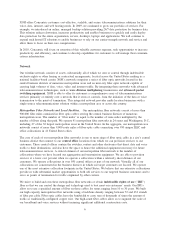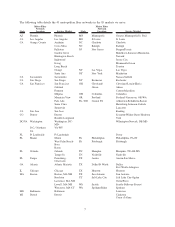XO Communications 2009 Annual Report Download - page 20
Download and view the complete annual report
Please find page 20 of the 2009 XO Communications annual report below. You can navigate through the pages in the report by either clicking on the pages listed below, or by using the keyword search tool below to find specific information within the annual report.DS3. Standard North American telecommunications industry digital signal format, which is distinguish-
able by bit rate (the number of binary digits transmitted per second). DS3 service has a bit rate of 44.736
megabits per second.
DSL (digital subscriber line). A family of technologies that provide digital data transmission over the
wires of a local telephone network.
Ethernet. A network configuration in which data is separated into “frames” for transmission. Ethernet
equipment scans the network to find the least-congested route for frames to travel from Point A to Point
B, thus resulting in greater speed and fewer errors in frame transmission.
Fiber Optics. Fiber optic technology involves sending laser light pulses across glass strands in order to
transmit digital information. Fiber optic cable is the medium of choice for the telecommunications and
cable industries. Fiber is immune to electrical interference and environmental factors that affect copper
wiring and satellite transmission.
Frame Relay. A data transmission technique used to send digital information in a relay of frames to one
or many destinations from one or many end-points.
Gbps (gigabits per second). One billion bits of information per second. The information-carrying
capacity of a circuit may be measured in Gbps.
GHz. One billion hertz, or cycles per second. A hertz is one cycle per second, and is the basic
measurement for bandwidth in analog terms.
GE or Gigabit Ethernet. A Copper or fiber-based ethernet network service, connection or port operating
at one billion bits per second.
Incumbent Local Exchange Carrier, or ILEC. Large local phone companies, such as Verizon Communi-
cations Inc., AT&T Inc. and Qwest Communications, Inc., which each owns the majority of the local
exchange network in its respective operating regions of the United States and dominates the market for
telecommunications services.
Indefeasible rights to use, or IRU. The right to use another company’s fiber optic circuit specifying the
time and bandwidth.
Interconnection. Interconnection of facilities between or among the networks of carriers, including
potential physical collocation of one carrier’s equipment in the other carrier’s premises to facilitate such
interconnection.
Interactive Voice Response, or IVR. A phone technology that allows a computer to detect voice and
touch tones using a normal phone call. The IVR system can respond with pre-recorded or dynamically
generated audio to further direct callers on how to proceed. IVR systems can be used to control almost
any function where the interface can be broken down into a series of simple menu choices.
Internet Service Provider, or ISP. Companies formed to provide access to the internet to consumers and
business customers via local networks.
Interexchange Carrier. A telecommunications company that provides telecommunications services
between local exchanges on an interstate or intrastate basis.
Local Area Network, or LAN. The interconnection of computers for the purpose of sharing files,
programs, and peripheral devices such as printers and high-speed modems. LANs may include dedicated
computers or file servers that provide a centralized source of shared files and programs.
Line-of-Sight, or LOS. Some through the air transmission media that operates at a frequency which
transmits in a perfectly straight line requiring the area between a transmitter and a receiver is clear of
obstructions.
Local Exchange. A geographic area defined by the appropriate state regulatory authority in which
telephone calls generally are transmitted without toll charges to the calling or called party.
16
























